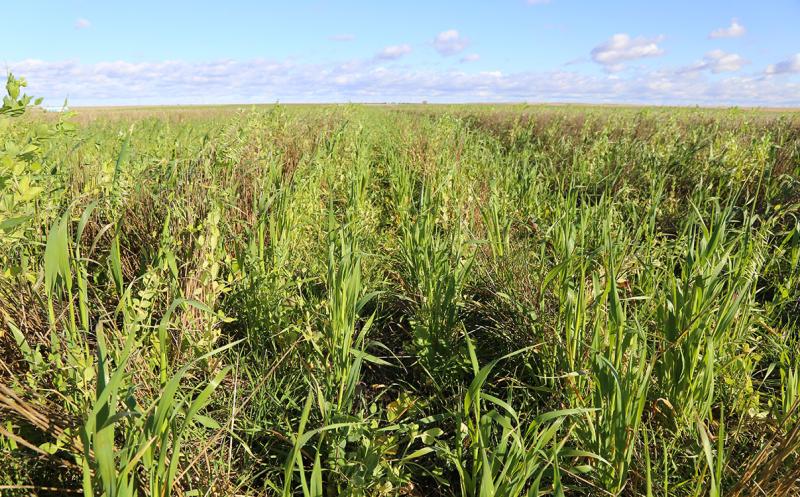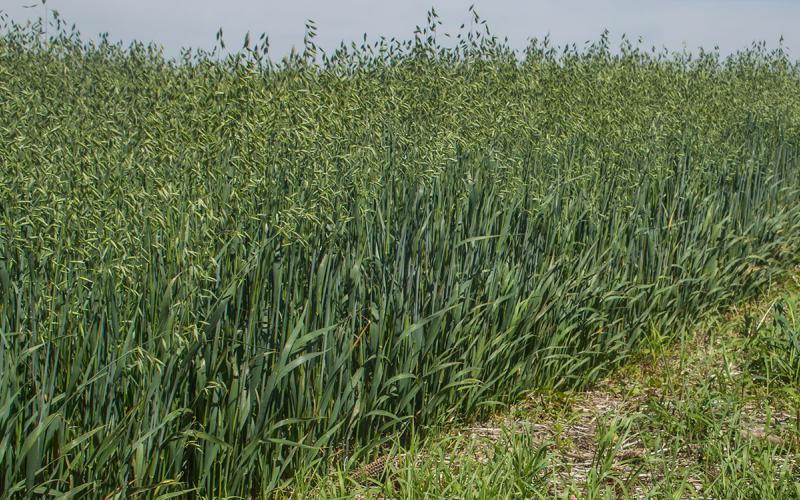
Currently, many policy makers are interested in removing carbon dioxide from the atmosphere and having it stored in the soil. The photosynthesis process happening in plants takes carbon dioxide from the atmosphere and converts it to organic carbon forms in the plant, and oxygen is released. Plant parts (roots and above-ground biomass) and these dead plant materials can be converted into stable soil organic compounds via the decomposition (microbial) process. Also, decaying animals and animal manures can be converted into stable soil organic carbon compounds when they remain on the soil surface or in the soil. Organic carbon concentrations in the soil can be increased by crop management decisions. Agricultural producers own and operate large quantities of land that have an abundant potential to store carbon and remove it from the atmosphere.
There are many land management strategies with potential to increase soil carbon concentration. These land management strategies include: retaining crop residues on the soil surface; reduced tillage; planting cover crops; crop rotations; adding animal manures, biochar, or other organic materials; and planting perennial vegetation on lands used for annual crop production. Adopting soil health principles into agricultural management practices can lead to increased soil carbon concentrations.
South Dakota Soil Management Studies

Studies conducted in South Dakota have evaluated the potential of these management activities to increase soil carbon. Some of the studies in South Dakota that measured soil carbon after soil health practices were applied are listed in Table 1 (see attachment at the end of this article). One study in Southeastern South Dakota found that planting a grass blend cover crop following rye for one year increased soil organic carbon by 15% in the 2-to-4-inch depth compared to no cover crops, a blend of legume and grass cover crops, and a legume cover crop blend (Tobin et al., 2020). Cover crops did not improve soil organic carbon in the 0-to-2-inch depth in this study (Tobin et al., 2020). Another study that removed crop residues and planted cover crops analyzed soil organic carbon concentration after 10 years in a corn-soybean rotation (Chalise et al., 2019). They found that planting a rye-vetch cover crop following corn and vetch following soybean did not increase soil organic carbon. However, removing crop residues lead to a 17% loss of soil organic carbon in the 0-to-2-inch depth, but it did not change soil organic carbon in the 2-to-6-inch depth (Chalise et al., 2019). Additionally, a study conducted in Brookings and Beresford South Dakota found that changing a 2-year corn- soybean rotation to a corn-soybean-winter-wheat-oat rotation increased soil organic carbon by 42% in the 0-to-2-inch depth but not in 2-to-24-inch depths in Brookings, South Dakota after 14 years (Maiga et al., 2019). At the Beresford, South Dakota location, soil organic carbon was 7% higher in the 0-to-2-inch depth and 50 % higher in the 12-to-24-inch depth in the four-year rotation after 24 years of the rotation (Maiga et al., 2019). Also, a study found that applying dairy cow manure for 12 years at Brookings at 12 and 24 tons/acre did not increase soil organic carbon concentration in the 0-to-16-inch depth (Sangotayo et al., 2023). However, applying beef cattle manure for 17 years at Beresford increased soil organic carbon when applied at 16.5 tons/acre (2.38 % compared to 1.82%), but did not increase soil organic carbon when applied at 8.3 tons/acre in the 0-to-16 inch depth range (Sangotayo et al., 2023). Additionally, a study at Beresford, South Dakota found that no-till increased soil organic carbon by 7% compared to conventional tillage after 23 years compared to conventional in the 0-to-12-inch depth, but total carbon stock was not different between the two tillage practices in the 0-to-24-inch depth (Alhameid et al., 2017). These mentioned studies show that agricultural management practices can increase soil carbon storage in South Dakota and that further research is necessary to identify other practices with positive effects on soil organic carbon.
In Summary
Agricultural practices which reduce soil disturbance (no tillage), increase crop rotation and cover crops, returning more carbon to soil (manure application, retaining crop residues, and planting cover crops), and incorporating livestock (manure application) have potential to increase soil organic carbon stored in the soil. However, these studies occurred over a long duration of time and still mostly only increased soil carbon stored near the surface. Patience is needed for these management practices to show increases in soil organic carbon when they are adopted.
References
- Alhameid, A., Ibrahim, M., Kumar, S., Sexton, P., & Schumacher, T. E. (2017). Soil organic carbon changes impacted by crop rotational diversity under no‐till farming in South Dakota, USA. Soil Science Society of America Journal, 81(4), 868-877.
- Chalise, K. S., Singh, S., Wegner, B. R., Kumar, S., Pérez‐Gutiérrez, J. D., Osborne, S. L., ... & Rohila, J. S. (2019). Cover crops and returning residue impact on soil organic carbon, bulk density, penetration resistance, water retention, infiltration, and soybean yield. Agronomy Journal, 111(1), 99-108.
- Maiga, A., Alhameid, A., Singh, S., Polat, A., Singh, J., Kumar, S., & Osborne, S. (2019). Responses of soil organic carbon, aggregate stability, carbon and nitrogen fractions to 15 and 24 years of no-till diversified crop rotations. Soil Research, 57(2), 149-157.
- Sangotayo, A. O., Chakraborty, P., Xu, S., Kumar, S., & Kovacs, P. (2023). Cattle manure application for 12 and 17 years enhanced depth distribution of soil organic carbon and X-ray computed tomography-derived pore characteristics. Scientific Reports, 13(1), 23042.
- Sturm, N. (2022). It's Not Just No-Till: Crop Rotations Are Key to Improving Soil Quality and Grain Yields at Dakota Lakes Research Farm. South Dakota State University.
- Tobin, C., Singh, S., Kumar, S., Wang, T., & Sexton, P. (2020). Demonstrating short-term impacts of grazing and cover crops on soil health and economic benefits in an integrated crop-livestock system in South Dakota. Open Journal of Soil Science, 10(03), 109.


